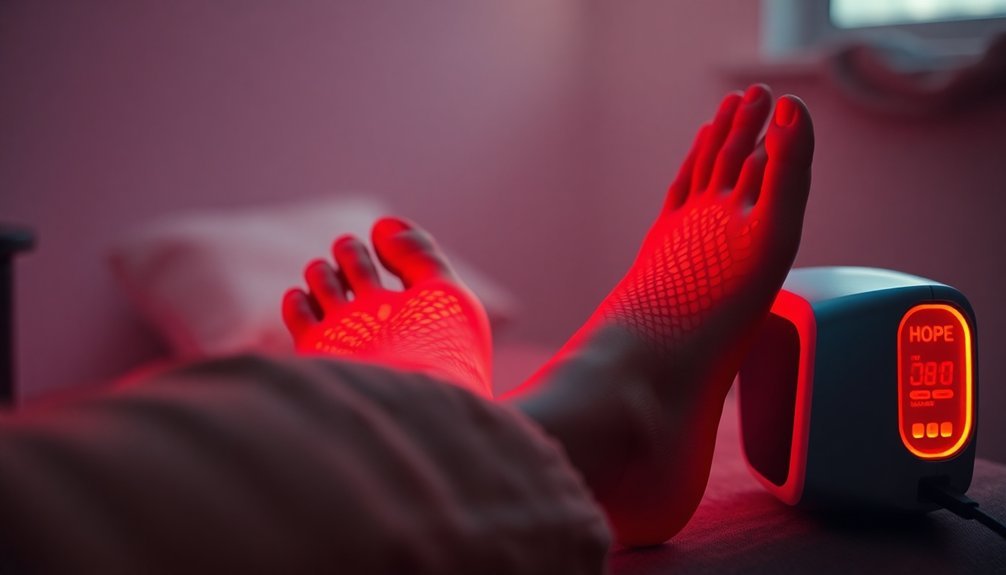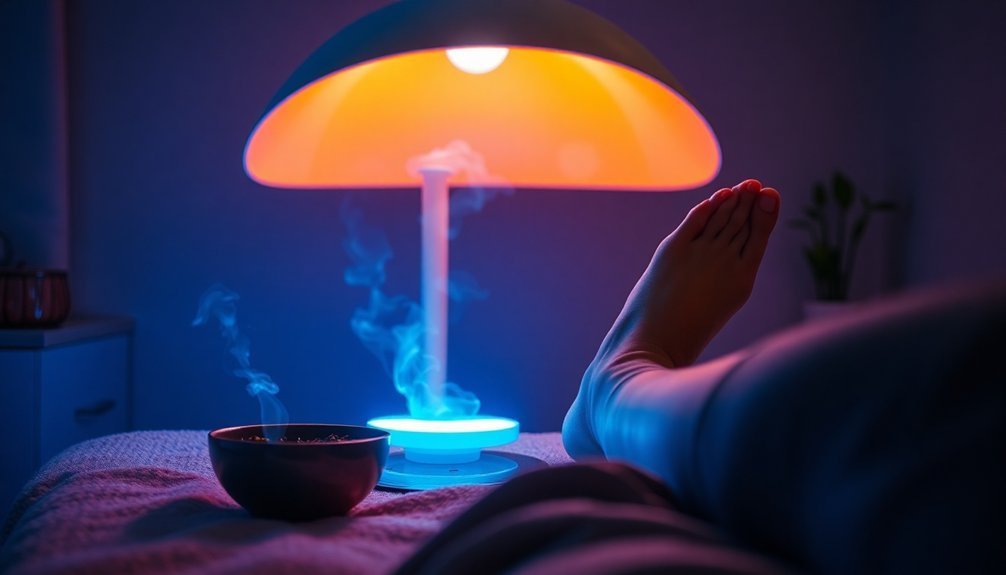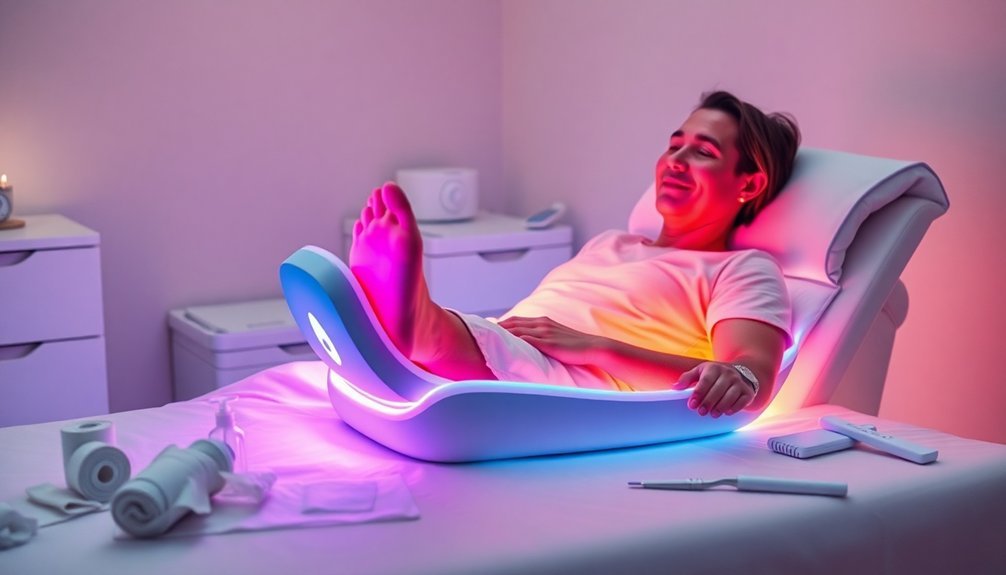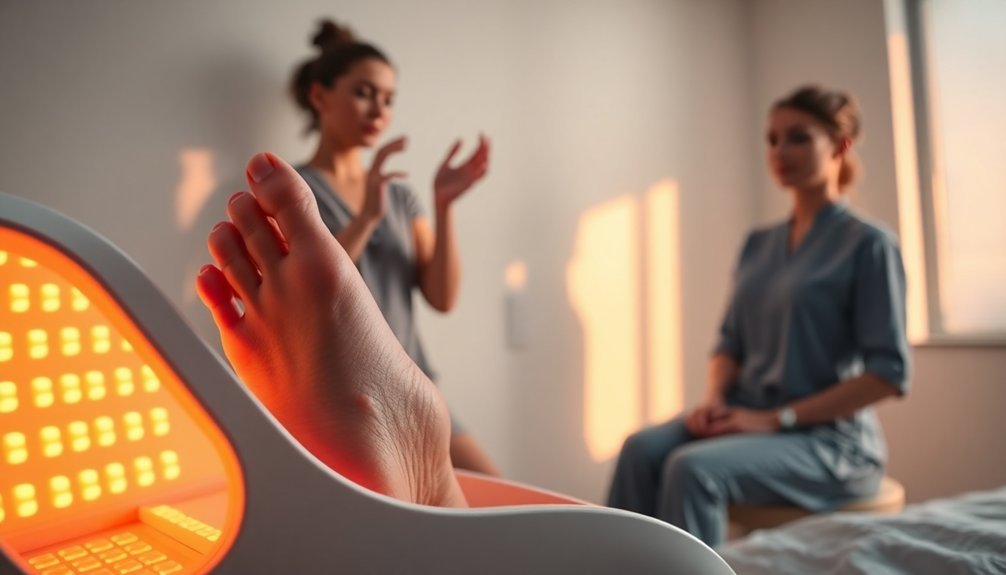Infrared therapy transforms diabetic foot recovery in several impactful ways. First, it improves circulation, enhancing blood flow to your feet, crucial for healing. Second, it accelerates wound healing by stimulating new blood vessel formation. You'll also find pain and inflammation reduction through boosted endorphin production, making recovery more manageable. Additionally, it supports enhanced granulation tissue formation, essential for closing wounds. Finally, when combined with conventional treatments, it greatly speeds up healing times. If you're curious about how these benefits could work for you, there's more to discover about this effective therapy.
Improved Circulation

Utilizing infrared therapy can greatly enhance circulation in your feet, which is essential for diabetic recovery. Far-infrared radiation (FIR) therapy promotes vessel dilation, leading to improved blood flow. You'll find that the dorsalis pedis artery sees increased blood circulation, ensuring essential nutrients reach the tissues in need.
By improving endothelial function, FIR therapy further contributes to better overall circulation, while reducing atherosclerosis allows your blood vessels to remain flexible and healthy. Moreover, infrared therapy increases blood flow and oxygenation to the affected areas, critical for tissue recovery. With near-infrared wavelengths, you can stimulate oxygen delivery to the tissues in your feet, and lowering your feet instead of elevating them can noticeably enhance this effect. This is particularly important, as adequate tissue oxygenation is essential for facilitating effective wound healing.
Consistent therapy sessions, around 3-4 hours daily, help maintain elevated tissue oxygen levels. As capillary formation improves through infrared radiation, your body can deliver oxygen more efficiently to the damaged areas. These improvements in circulation not only support healing but also help alleviate symptoms like pain and tingling.
Accelerated Wound Healing
Frequently, infrared therapy shows remarkable potential in accelerating wound healing, especially for those with diabetic foot ulcers. This therapy stimulates angiogenesis, increasing the levels of vascular endothelial growth factor (VEGF) and other essential factors. As a result, you'll notice improved blood flow to the wound area, which enhances healing. The IRE device used in studies has been cleared by the FDA for enhancing circulation and reducing pain.
The formation of new blood vessels—neovascularization—makes a considerable difference, allowing more nutrients and oxygen to reach the site.
You can also expect enhanced cellular proliferation and regeneration with infrared therapy. This treatment boosts the activity of fibroblasts, which are vital for producing collagen and other components needed for closing wounds.
You'll likely see increased cellular migration and viability, leading to faster healing times. Clinical studies reveal that patients using infrared therapy experience a marked improvement in healing rates compared to untreated controls. Wound sizes decrease considerably, and complete healing occurs more rapidly.
It's no wonder that medical professionals recommend infrared therapy as an effective strategy for accelerating diabetic foot ulcer recovery. With this approach, you're not just healing; you're enhancing your body's natural ability to recover.
Pain and Inflammation Reduction

After experiencing accelerated wound healing, you might also find relief from the pain and inflammation often associated with diabetic foot issues.
Infrared therapy plays an essential role in this process by stimulating endorphin production, your body's natural painkillers. Patients undergoing this therapy report a substantial drop in pain levels, with averages going from 8 to 3 on the Visual Analog Scale after just ten sessions. That's a remarkable 67% reduction in pain intensity.
One reason this therapy is so effective is its ability to enhance local blood flow, delivering critical oxygen and nutrients to damaged nerves. It promotes nitric oxide release, which increases circulation and helps cleanse away toxins. Additionally, infrared therapy is recognized for its ability to treat nerve damage, making it an invaluable option for diabetic patients.
Additionally, infrared light therapy has been shown to alleviate pain related to diabetic neuropathy, making day-to-day activities more manageable for you.
In clinical settings, studies have revealed significant improvements in both pain reduction and healing times compared to traditional treatments.
Plus, it's a non-invasive option that you can easily use at home, allowing you to prioritize your recovery without the hassle of complex therapies.
With infrared therapy, relief from pain and inflammation isn't just a possibility, but an attainable reality.
Enhanced Granulation Tissue Formation
Infrared therapy greatly boosts granulation tissue formation, which is essential for healing diabetic foot ulcers. Studies show that when you undergo infrared radiation therapy, the granulation tissue scores notably increase. In fact, this approach yields better tissue formation outcomes, with a p-value of less than 0.001 indicating a substantial difference.
Photobiomodulation (PBM), closely related to infrared therapy, has also demonstrated its effectiveness by promoting granulation tissue in diabetic mice when treated daily. With specific doses like 4.7 J/cm² three times a week, you can see a marked improvement in wound healing.
This therapy enhances cellular autocrine signaling, leading to increased cell proliferation and migration. As a result, the release of beneficial cytokines such as IL-6 and bFGF increases in your fibroblasts. Additionally, you'll notice better collagen synthesis and cellular viability.
In terms of healing acceleration, conditions treated with infrared therapy experience a considerable reduction in wound area—30-50% compared to control groups. Daily or thrice-weekly sessions deliver the most effective results, transforming your wound recovery journey.
Adjuvant to Conventional Treatments

Combining infrared therapy with conventional treatments can greatly amplify the healing process for diabetic foot ulcers. When used alongside traditional dressings, studies reveal that the mean healing time drops considerably, with a risk ratio of 1.93 showing a higher rate of ulcer healing. Imagine reducing the pain and frustration of prolonged healing while effectively managing inflammation and infection!
| Benefits of Infrared Therapy | Conventional Treatments |
|---|---|
| Accelerates healing by 893.56 mm | Heals at 375.30 mm |
| Enhances blood flow by +6.54 | Limited blood circulation |
| Decreases wound pain by -4.33 | Pain relief varies widely |
| Compatible with antibiotics/Surgery | Often standalone treatment |
Frequently Asked Questions
Is Infrared Therapy Safe for All Diabetic Patients?
Infrared therapy isn't safe for all diabetic patients. You should consult your healthcare provider to determine if you're eligible, especially if you're on medications like steroids or antibiotics that might interfere with healing.
How Many Sessions of Infrared Therapy Are Typically Needed?
You'll typically need daily sessions of infrared therapy for 30 minutes, or 3-5 times a week, depending on your response and ulcer severity. Consistency plays a key role in effective treatment and healing progress.
Can Infrared Therapy Be Performed at Home?
Yes, you can perform infrared therapy at home. Portable, user-friendly devices are available, allowing you to easily self-apply treatments daily. Just follow guidelines for effective use, ensuring consistent application for the best results.
Are There Any Side Effects Associated With Infrared Therapy?
Yes, there are side effects associated with infrared therapy. You might experience headaches, skin irritation, eye strain, or muscle spasms. Always follow guidelines, use protective gear, and consult a doctor if you have concerns.
How Does Infrared Therapy Compare to Other Treatment Methods?
When comparing infrared therapy to other treatments, you'll find it considerably speeds up healing, reduces ulcer size, and improves comfort. It's effective and safe, often outperforming conventional methods without increasing risks or complications.
In Summary
Incorporating infrared therapy into your diabetic foot recovery can make a significant difference in your healing process. By improving circulation, accelerating wound healing, reducing pain and inflammation, fostering granulation tissue, and complementing conventional treatments, you're setting yourself up for success. Embracing this innovative approach not only enhances your comfort but also speeds up recovery. Don't hesitate to explore how infrared therapy can be a valuable asset in your journey toward better foot health.





Leave a Reply